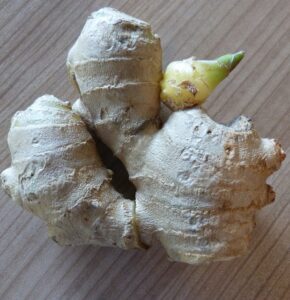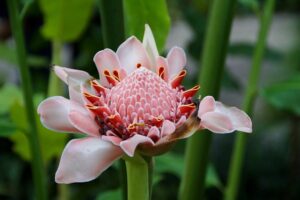Ginger, known for its spicy, aromatic rhizomes, is a beloved ingredient in cuisines worldwide. Growing ginger at home is an exciting and rewarding gardening project, one that I’ve personally found to be both simple and fascinating. Ginger thrives in warm, moist conditions, making it perfect for indoor cultivation if outdoor climates are less than ideal.
In the Root of It All: Why Grow Ginger at Home?
My journey with growing ginger began with a small ginger rhizome, which I purchased from my local grocery store. I made sure to choose a piece that was plump and had visible eye buds, similar to those you see on potatoes when they’re ready to sprout. After soaking the ginger overnight in warm water to stimulate growth, I planted it in a pot filled with rich, well-draining soil, ensuring the eye buds were facing upwards. The anticipation of waiting for those first green shoots to emerge was truly a test of patience, but within a couple of weeks, I was rewarded with the sight of new growth. Can you grow ginger root that was store-bought? The answer, to my delight, was a resounding yes. This revelation was the first step into what would become a deeply fulfilling adventure.
The Expense Factor
Given its widespread popularity and extensive list of health benefits, you might wonder why ginger can be relatively expensive compared to other herbs and spices. Growing ginger at home is a cost-effective way to have an endless supply of this versatile root on hand. Not only will you save money by growing your own ginger, but you’ll also benefit from its freshness and organic nature.Several factors contribute to ginger’s cost. Firstly, ginger requires a specific climate to thrive—warm and humid conditions are essential, limiting the geographical areas where it can be successfully cultivated. This restriction means that countries not suited for ginger cultivation have to import it, adding transportation and import costs to its price.
Additionally, the ginger plant takes about eight to ten months to reach maturity. The lengthy growing period, coupled with the need for significant amounts of water and attention to prevent disease and pests, contributes to higher labor and production costs. Lastly, the increasing demand for organic ginger, which is grown without synthetic pesticides and fertilizers, tends to be more labor-intensive and costly to produce, further driving up its market price. These factors combined make ginger a more expensive commodity in the spice market. Growing ginger at home is a cost-effective way to have an endless supply of this versatile root on hand. Not only will you save money by growing your own ginger, but you’ll also benefit from its freshness and organic nature.
Selecting the Right Rhizome
The key to a flourishing ginger enterprise lies at the very beginning – choosing a healthy rhizome. Ginger is not particularly difficult to grow, but it does demand patience and attention to specific details. It starts with the selection of the ginger root itself. Opt for plump, fresh-looking roots with visible eyes, much like those of potatoes. One critical step I learned early on is the importance of soaking the ginger root in warm water overnight before planting. This helps to wake up the ‘sleeping’ buds, encouraging them to sprout more quickly.
Spotting a Gem Among Rhizomes
- Firmness Over Fragility: The rhizome should be plump and solid, not shriveled or soft, indicating dehydration or rot.
- Sizing Up Growth Potential: Opt for a larger rhizome, which often equates to more eyes and potential shoots.
- Eye on the Prize: Visible nodes or ‘eyes’ are where the action happens, signaling prospective growth. The more, the merrier.
Planting Your Fortunes
Once you’ve selected your prized rhizome, it’s time to lay the groundwork for its planting. This stage is critical, setting the foundation for the ginger’s growth.

Preparing the Patient for the Procedure
- The Soak and Swell Strategy: Submerge the ginger in warm water overnight to rehydrate and wake it up gently. This mimics the rainfall that coaxes ginger from the soil in the wild.
- A Home in Earth Heeds Depth: A pot at least 12 inches deep is prudent to accommodate ginger’s spacious spreading. Add a layer of stones at the bottom for drainage.
- Savvy Soil and Savory Settings: A well-draining, moisture-retentive potting mix is best. A mixing of potting soil and compost should provide the perfect blend for nurtured nutrition.
Planting the Ginger
Choosing where to plant ginger is next. Can you grow ginger indoors all year round? Absolutely. In fact, growing ginger in pots indoors is a fantastic way to keep the plant thriving regardless of the external weather conditions. Ginger does not require full sun and can flourish in indirect sunlight, making it an ideal plant for indoor cultivation. However, it’s essential to ensure the pot is sufficiently large—ginger prefers spreads out more than it digs down. The size pot needed to successfully grow ginger is at least 12 inches wide and deep. Larger would probably be better if your goal is a constant supply of ginger.
Step by Step to Sowing
- Layering the Luminary: Place the ginger just below the soil line with the eyes facing up. Firmly but gently pat down the soil to secure it in place.
- Dotty About Drainage: Water the ginger immediately after planting, allowing the excess to escape through the pot’s drainage holes. Don’t drown it; just moisten the soil.
In What Zones Can Ginger Grow Outside?
Ginger can be grown outside in zones 9-12, as long as the temperature stays above 50°F (10°C). In colder areas, ginger can still be grown outdoors during the warmer months but will need to be brought indoors or protected from frost during the winter. It is also possible to grow ginger in a greenhouse year-round. Perhaps the easiest way to grow ginger inside or out is in the appropriate size pot, at least 12 inches wide and deep, which you can easily move inside if your weather threatens to drop below 50℉. You may want to keep this on a coaster with wheels for easy moving.
Caring for Your Ginger Plant
Nurturing your ginger plant is a delicate dance of provision and finesse. Like any plant, ginger has its preferences, and the better you learn them, the better your harvest.
Timing is the Secret Ingredient
- Watering Wisdom: Ginger likes its feet wet but not sodden. A simple test is to poke a finger into the soil. If the top inch is dry, it’s time to water.
- Solar Symbiosis: Indirect sunlight with a splash of the real deal is Ginger’s idea of ‘just right.’ A south-facing window could be the sweet spot. If growing outside, pick a dappled shade spot, or some other place with more indirect sunlight. Ginger won’t respond well to the direct harsh summer sun.
- Does ginger need a grow light inside? No, not necessarily. However, it may be necessary if you don’t have access to a bright window with indirect sunlight.
- Fertilization Finesse: Ginger is a heavy feeder and loves its own space to grow. Prepare the pot by adding rich soil and compost from your bin or store-bought organic matter. Keep an eye on flowers that zap energy from Fertilize your ginger plant once a month with a balanced mix, higher in potassium for robust rhizome growth.
Harvesting Your Bounty
Ginger’s growth may seem slow at first, but with patience, you will witness the small shoots emerging from the soil, evolving into a lush plant. It’s not just about the ginger root; the plant itself is quite beautiful, with its tall, thin stalks and green leaves. Yes, you can eat ginger leaves – they are fragrant and can be used in teas or cooking, offering a milder flavor than the root.
Stage and Age for Harvest
- The Scent of Spices: A mature ginger plant, often 10-12 months after planting, will give off a pungent aroma when ready to harvest.
- Out and About Rhizomes: Gently dig around the base of the ginger to harvest rhizomes without disturbing the main plant. Leave a portion to propagate and perpetuate your harvest cycle.
Common Challenges and Solutions
The road to ginger nirvana is not without its bumps. We are about to tackle the adversaries that plague ginger growers.
Foes in the Foliage
- Mold Mannikins: Ensure adequate air circulation around your ginger and aim to keep the soil draining well to fight off mold.
- Pest Predicaments: Isolate affected plants and treat with a horticultural soap or neem oil, either of which should dispatch common pests like spider mites and aphids.
- Growth Glitches: If your ginger is lagging, assess feeding and nurturing routines. Sometimes, a simple adjustment can revitalize your crop.
Does Ginger Grow Back Every Year?
Ginger does indeed grow back every year if cared for correctly. It prefers warm climates and will stop growing once temperatures drop below 50°F (10°C). When winter approaches, if you’re growing ginger outdoors, it’s a good idea to mulch heavily over the bed to protect it from cold weather or, if potted, move the plant indoors. A heated greenhouse might also be an option. Ginger will not survive freezing, so if your ground has a deep frost line, without protection it will die.
Storing and Using Harvested Ginger
Once your ginger has been harvested, it’s time to blend the aromatic results into your daily life. Here’s how to store your ginger and keep the spice alive.
A Storage Strategy
- Simmered in Preservation: Store your ginger in a cool, dry place, or even better, in the freezer. Keep it whole, grated, or as a paste to maintain its potent profile.
- Everyday Elixirs: Use fresh or powdered ginger in stir-fries, teas, and salsas. The possibilities are as varied as your culinary imagination.
The Enduring Benefits of Homegrown Ginger
Growing ginger at home is more than just a botanical pursuit; it’s a holistic lifestyle choice that rewards your vitality as much as your verve.
From Soil to Remedies
- The Health Gem in Ginger: Ginger is renowned for its anti-inflammatory and digestive health properties, and what’s fresher than ginger straight from your own garden?
- A Joy Rooted in Growth: The satisfaction of rearing a plant from a small piece of rhizome to a bountiful bush that can supply you for years is a joy like few others.
Conclusion
Through my ginger-growing adventure, I’ve learned that anyone can grow this versatile plant. Whether you have a vast garden or a small balcony for a container garden, ginger can be grown indoors or out, with the right protection. With this guide, you are primed to start your own ginger-growing venture, to witness the earthy tang of transformation in your own kitchen.

